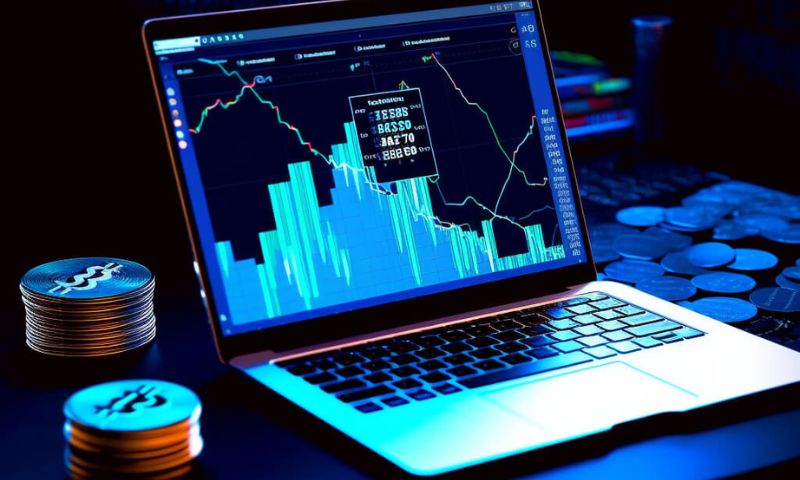What is crypto exchange liquidity? It’s the magic that makes your trades quick and smooth. Ever tried selling a coin and it felt like pushing a boulder up a hill? That’s bad liquidity. Now imagine that same boulder rolling down with just a nudge – that’s great liquidity. It’s vital for a good trade but often slips under the radar. Let’s dive into its core and why it matters to you.
Demystifying Crypto Exchange Liquidity
Understanding Crypto Exchange Liquidity
When you trade in crypto, you deal with liquidity. Think of it like a busy market. More people and goods mean you can buy or sell fast. This is how crypto exchanges work. If many people trade a crypto coin, you can expect that coin to have good liquidity. This simplifies trading a lot.
Cryptocurrency Liquidity Explained
Imagine you want to sell apples in a small town. If few people want apples, selling them gets hard. Same goes for trading crypto. Good cryptocurrency liquidity means lots of buyers and sellers are always ready. It keeps prices stable and trading smooth. Without it, prices may suddenly jump, and trading can stall.
Good liquidity lets you trade at prices you expect. This stops big price changes from small trades. It’s a key part of any crypto market. It lets you trade and not worry about moving the price too much.
Liquidity pools are groups of funds locked in a smart contract. They help trades happen fast. They use automated market makers to set prices. This is not like traditional trading. It’s new and helps crypto stay liquid round the clock.
High liquidity in crypto means a thick order book. This has lots of buy and sell orders sitting there. It tells you that you can make big trades without big price moves. Low liquidity is the opposite. It leads to wide gaps in buying and selling prices. This means more cost for traders, known as slippage.
Crypto exchanges show their liquidity through numbers like trading volume. Volume means how much of a coin gets traded in a set time. A high number means lots of trades. This often means good liquidity.
But, risks come with crypto liquidity too. If lots of people try to sell and few want to buy, a liquidity crisis can happen. Prices may crash as sellers fight to find buyers. Managing this risk is a big deal for anyone trading in crypto.
Liquidity impacts prices. It smooths out bumps from trade to trade. With less worry about price jumps, traders can focus on their strategies. This means a market where everyone has a fair chance to trade well.
To sum up, this whole crypto liquidity thing matters a lot. A liquid market makes sure trades happen at fair prices. It helps people like you and me trade without stirring up big price waves. It’s what keeps the crypto market ticking day in, day out. And, when we trade, isn’t that what we all want? A market that works well and lets us do our thing.
The Mechanics of the Market: How Liquidity Impacts Trading
Importance of Liquidity in Trading
Have you ever heard friends talk about the importance of liquidity in trading? It’s like having a big pool to swim in. If the pool is full, you can dive and swim easily. This is what we call deep liquidity in the crypto markets. It means there are lots of buyers and sellers ready to trade at any time. This makes trading smooth, with prices that don’t jump around too much.
Now, high liquidity is good for trading. It helps you buy or sell your crypto at good prices. And fast! In a low liquidity market, it’s harder to trade without affecting the price too much. Nobody wants to sell their car only to find out they’ve caused the price of all cars to drop!
Liquidity keeps markets fair. It’s kind of like magic that holds trading together. Think of water in a pipe. If there’s enough water (liquidity), it flows well. If not, the flow stops – this is a liquidity crisis. We don’t want that.
Measuring Liquidity in Crypto Exchanges
Now, how do we measure this pool of liquid goodness in crypto exchanges? Well, there are some cool tools for that. One is the order book depth. It’s like looking at a store shelf to see how much of an item they have. More stuff means more to buy or sell.
Another tool is the bid-ask spread. It’s the gap between what buyers want to pay and what sellers want. A small gap means good liquidity, like when you can agree on a pizza topping with your friend easily.
We also look at trading volume. It’s how much crypto trades in a day on an exchange. A busy exchange with lots of trades means good liquidity. It’s like a busy shop with many customers.
Slippage is another big word in trading. It’s when there’s not enough liquidity, and your trade happens at a different price than you wanted. Like when you try to grab a toy on sale, but it’s gone, and you must pay more.
Lastly, we’ve got things like liquidity pools in blockchain and liquidity providers. They’re the heroes adding water to our pool. They use strategies and magic called automated market makers. This makes sure there’s enough to trade without big price changes.
And that’s the scoop on how liquidity waterproofs our crypto trading adventures. It makes sure we can dive in and out of trades without worry. So, next time you trade, remember the magic of liquidity. It’s the true secret to successful, seamless trading in the wild world of cryptocurrency.
Innovations in Ensuring Market Fluidity
The Role of Liquidity Providers and Automated Market Makers
Ever wonder how you can trade crypto so easily? It’s all thanks to liquidity. Liquidity means you can buy or sell without a big price change. High liquidity makes trading smooth and prices stable.
So, who makes sure there is enough liquidity? Here come liquidity providers and automated market makers (AMMs). Think of liquidity providers as the super helpers of the market. They put their money on both sides, buy and sell, of an asset’s price. This helps you trade anytime without waiting for someone else to match your trade.
Now let’s talk AMMs. They are like smart robots that set prices and hold the funds in a liquidity pool. A liquidity pool is like a big pot of money from many investors. These AMMs let you trade with the pool rather than a single person. This is great because you don’t need a partner to trade.
Exploring Liquidity Pools and Decentralized Exchanges
Ready for a dip in the liquidity pool? Liquidity pools are the heart of decentralized exchanges. These pools hold two or more crypto assets. Traders can switch one for another without a middle person. People add their cryptos to these pools and, in return, they get rewards. It’s a win-win!
What’s so special about decentralized exchanges? They run all the time! No breaks, no holidays. You can trade whenever you want. Decentralized means they are not run by one company or person. Plus, they are super safe as they work on blockchain tech.
To keep everything fair, liquidity pools use a cool formula. It makes sure that the amount you trade impacts the price just a bit. This shields us from huge price swings.
In the end, keeping markets liquid is like making sure water flows smoothly in a river. We need it to trade fast and at fair prices. With the help of providers, AMMs, and pools, trading in crypto stays easy as pie. So next time you trade, remember the magic of liquidity behind the scenes!
Navigating the Challenges of Crypto Liquidity
Assessing Crypto Liquidity Risks
Let’s talk real about money in crypto exchanges. Think of it like a busy market. You want to buy or sell fast. That’s liquidity – quick and smooth trading. What if you cannot? That’s a liquidity risk. This risk means you might sell for less or buy for more. It hurts, right?
Now, imagine lots of buyers and sellers always ready. That’s deep liquidity crypto markets have. It helps prices stay steady. But when few are ready to trade, it’s the opposite. Prices can jump like crazy; this is high liquidity vs low liquidity crypto.
Remember slippage in cryptocurrency trading? It happens during these jumps. You trade at a different price than expected. This can lose you money. So, crypto liquidity risks are real. For new traders, it’s a big deal to understand crypto exchange liquidity. It can change the game.
Measuring liquidity in crypto exchanges is key. How fast can you trade? Look at the order book depth crypto. It shows all buys and sells waiting. More depth is more liquidity. It’s like having many doors in a room – easier to move in and out.
Watch out for the bid-ask spread in crypto too. It is the gap between the lowest sell and highest buy offer. A small gap is good. It means the market’s healthy and you’ll likely trade at a fair price.
Strategies for Improving Exchange Liquidity
So, what can exchanges do to pump up liquidity? A lot, actually. First, roll out the red carpet for liquidity providers in blockchain. They are like the market’s lifeblood.
Exchange liquidity solutions could mean using liquidity pools. What’s that? It’s a bunch of crypto funds locked in a smart contract. People pool their coins here. It’s like a pot of gold that anyone can trade with.
Another cool thing? Automated market makers. They’re like robot traders. They keep the market moving by setting prices and trading 24/7. They use formulas to make sure prices make sense with the real world. They keep liquidity going, even when most are asleep.
Do not forget about crypto market making. It’s firms or people who trade a lot. They keep buying and selling to make sure others can too. They take risks but also help the market a lot.
Lastly, stablecoin liquidity matters. Stablecoins are like digital dollars. They’re steady in price, which helps calm the market down. It’s easier to trade when you know what your coin is worth. That’s why stablecoins are like anchors in choppy seas.
Exchanges are also getting smarter, using tools to watch prices and trades. They can now spot a liquidity crisis in crypto fast and act before it’s too late.
So, here we are, unpacking the tricks behind smooth trading. It’s a mix of science and strategy. We need to keep our eyes open for risks but know there are ways to build a strong, liquid market. Whether you’re trading or just curious, that’s the real scoop on understanding crypto exchange liquidity.
In this post, we dived deep into crypto exchange liquidity. We started by explaining what it is and why it’s vital for trading. Remember, good liquidity means you can buy and sell crypto fast without big price changes. We also talked about how liquidity is measured and why that’s important for traders.
Then we looked at how the market works and how liquidity affects your trading. We explored how liquidity providers and automated market makers keep the market moving. They help make sure buyers and sellers can match up. We also checked out liquidity pools and decentralized exchanges. These are new ways to help keep everything flowing smoothly.
Lastly, we tackled the challenges. We looked at risks and shared tips on how to make liquidity better.
Trading in crypto can be tricky, but knowing about liquidity helps a lot. Use this knowledge to make smarter choices in the market. Stay safe and trade smart!
Q&A :
What does liquidity mean in a crypto exchange?
Liquidity in a crypto exchange refers to how easily and quickly a cryptocurrency can be bought or sold without affecting the overall market price. High liquidity indicates a robust market with many participants and transactions, allowing for smoother and more stable trading experiences.
How does liquidity impact traders on crypto platforms?
Liquidity impacts traders by determining the ease with which they can enter or exit positions. In a highly liquid market, traders can execute large orders without significant price slippage, ensuring closer adherence to anticipated entry and exit points. Conversely, low liquidity can lead to high slippage, potentially affecting the profitability of trades.
Why is high liquidity important for a crypto exchange?
High liquidity is crucial for a crypto exchange as it ensures lower transaction costs, faster transaction times, and more stable prices. This tends to attract more users to the platform, which in turn helps maintain and increase the liquidity further, creating a positive cycle that benefits both the exchange and its clients.
How can a crypto exchange improve its liquidity?
A crypto exchange can improve its liquidity by incentivizing market makers to participate, integrating with larger liquidity pools, offering a wide variety of trading pairs, ensuring a user-friendly platform experience, and maintaining high-security standards to foster trust and increase its user base.
What are liquidity pools in cryptocurrency exchanges?
Liquidity pools are reserves of cryptocurrencies that are locked in a smart contract to facilitate trading by providing liquidity on decentralized exchanges (DEXs). These pools allow for the trading of crypto assets without the need for traditional market makers, as prices are determined by a constant mathematical formula based on the relative supply of the involved tokens in the pool.






